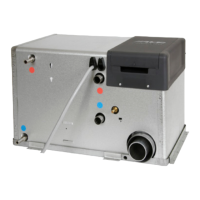5:1 IMPORTANT INFORMATION
• The boiler must not be started if there is no ethylene glycol uid in the system. For this reason, never connect
12 V supply to the boiler before the heating system has been lled with ethylene glycol uid.
• Always drain the hot water tank in the heating system completely when there is a risk of frost and when the vehicle is
not being used. Otherwise there is a risk of serious frost damage.
5:2 PLANNING THE HEATING SYSTEM
• There a couple rules of thumb that should be followed in order to obtain as an effective heating system as possible.
Convectors
Air ow
• Air circulation
To make the best use of the water-borne heating, it is important that air can circulate freely through air gaps under
bunks, and behind backrests and wall-mounted cabinets. If, for example, the vehicle has a tted carpet, make sure
the carpet does not block the air supply to the convectors. It is equally important that curtains, cushions or blan-
kets do not block the ow of air behind backrests and wall cabinets.
• Design of the air gaps
Air gaps between walls and furnishings should have an airtight, smooth surface on both sides and be designed so
they are narrower at the top edge (approx. 20-25 mm) in order to increase the air speed; at the bottom, the air gap
must be sealed against the convector. It is best if the air gap has a uniform incline between walls and furnishings.
There should also be a free air ow to the convectors, this air gap should be at least 40 mm. Air gaps in top cup-
boards should be at least 20 mm at the bottom edge and with a sufciently wide opening at the top edge to obtain
satisfactory air circulation.
• Placing the boiler
The best place for the boiler is in a wardrobe or storage space, but it can also be placed in the double oor of the
vehicle. When choosing the location, bear in mind that it has to be possible to remove the service panel (Figure
A.1) and that room should be left for replacement of components during servicing.
The rating plate (Figure A.2) on the boiler must be legible after installation.
When choosing the location, also bear in mind that the ue (Figure A.3) must not end up on the same side as any
awning. Bear in mind the need to remove the boiler for servicing/replacement.
• Direction of ow, ethylene glycol uid
To obtain the best warming comfort in the vehicle, you should always install the heating system so the heat from
the boiler is led to the front of the vehicle rst. This is because more heat is needed to warm up the driver space
of mobile homes as well as the fact that one usually want it to be a little cooler in the sleeping area, both in mobile
homes and caravans.
• Amount of convectors
To obtain the best heating comfort in the vehicle, a sufcient amount of convectors should be used. One easy way
to estimate this is to multiply the vehicle's length by 1.5.
Example: If the vehicle is 7.5 metre long, the length of convectors needed is about 11 metres. However, this is just
a rule of thumb, to be completely certain of obtaining the result wanted, a cold cambre test needs to be conducted
because there are many different factors that are crucial for how effectively a vehicle is warmed up; the vehicle's
insulation, the design of the vehicle as well as the vehicle's furnishings and so on.
• Placing convectors
The convectors have to be placed evenly spread throughout the vehicle, these are placed between outer walls and
furniture at a height of at least 100 mm from the oor and should be under each window; convectors can also be
placed in intermediate oors. If there is a need for extra convectors, these can be placed one above the other.
One metre convector corresponds to approx. 400 W, if a convector is placed above another one, the output is
100% for the lower one and 50% for the upper one. Example: If two convectors, each of which are one metre long, are
placed one above the other, the output is approx. 400 W + 200 W.

